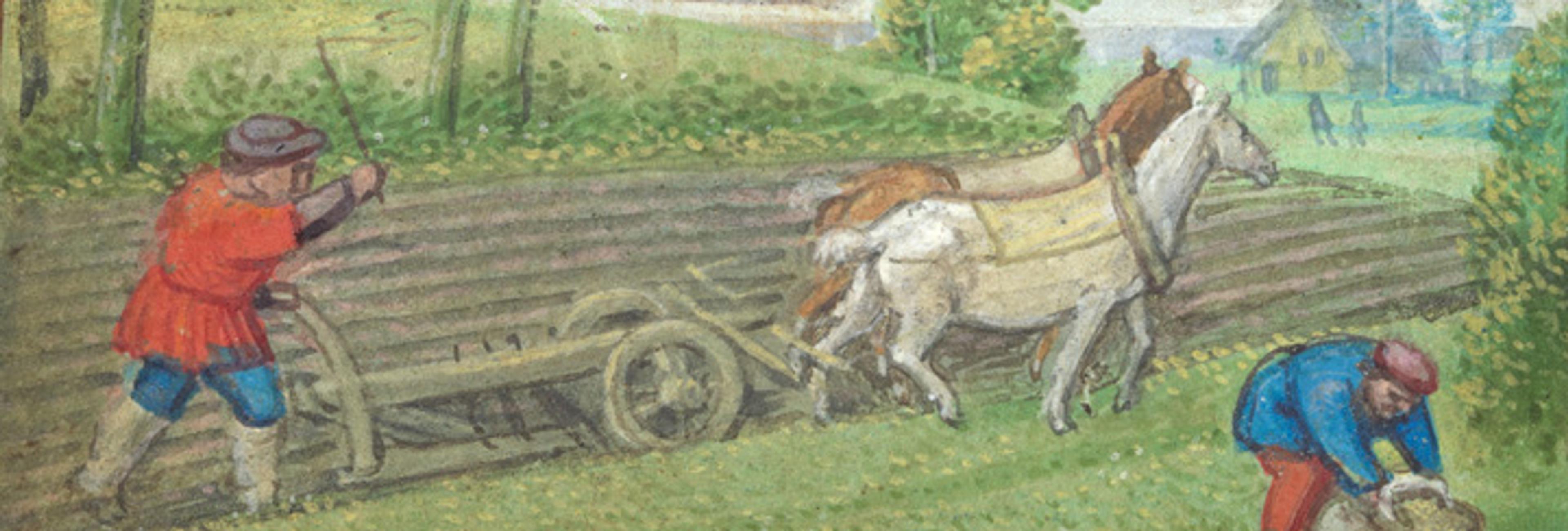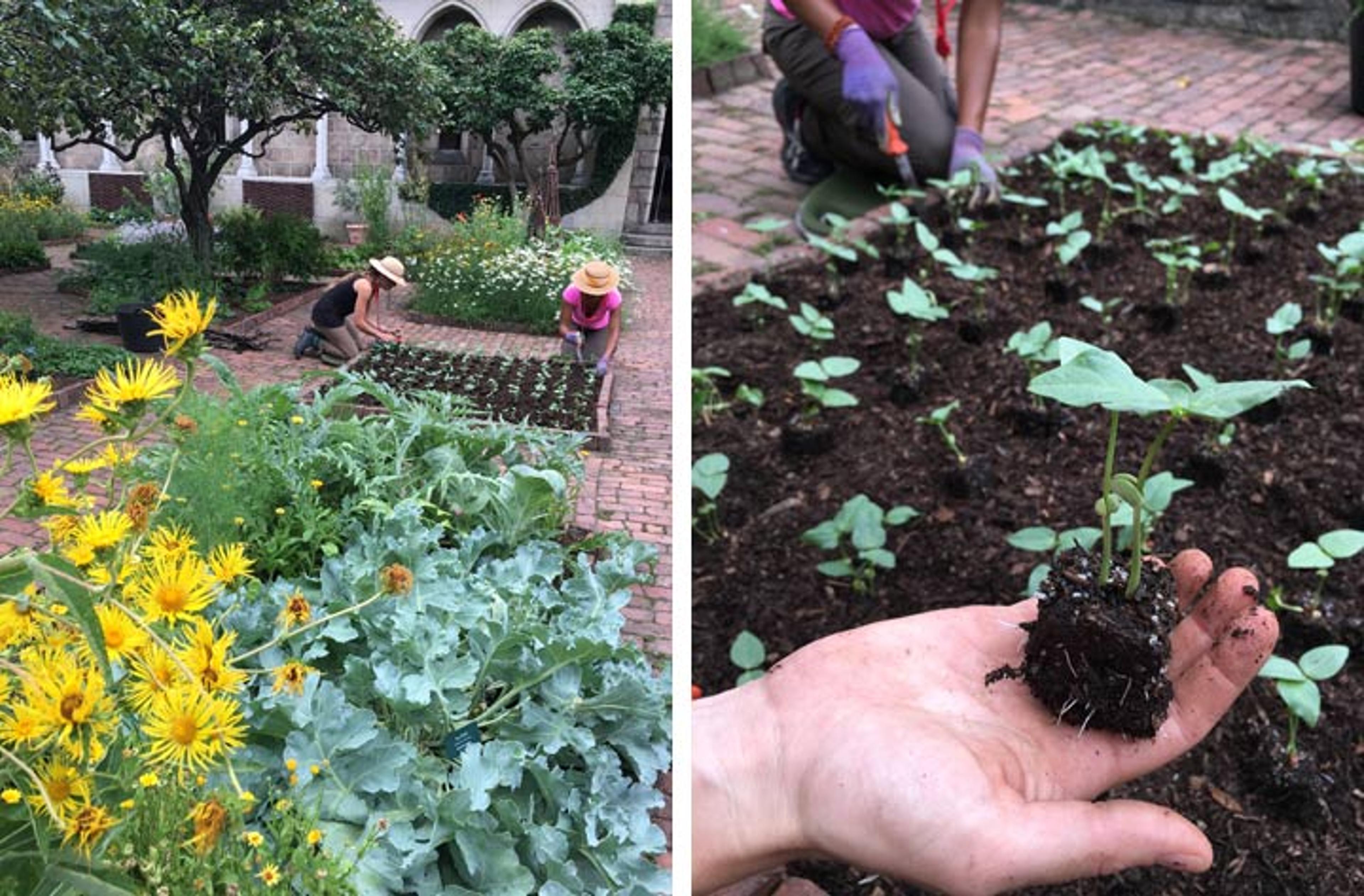Harrow and Fallow

A man with a moldboard plow. Simon Bening (Netherlandish, 1483/84–1561). Book of Hours (detail), ca. 1530–35. Made in Bruges, present-day Belgium. Ink, tempera, and gold on parchment; modern red leather binding; Manuscript: 2 9/16 x 2 1/16 x 1 1/8 in. (6.5 x 5.2 x 2.9 cm) Folio: 2 5/16 x 1 5/8 in. (5.9 x 4.2 cm) Illumination only: 1 7/8 x 1 5/16 in. (4.8 x 3.4 cm) Text area: 1 7/16 in. x 1 in. (3.6 x 2.6 cm). The Metropolitan Museum of Art, New York, The Cloisters Collection, 2015 (2015.706)
«In a previous post, I discussed the cultivation of medieval grains in our herb garden. As with much in the garden, the beauty of the grasses are fleeting and by mid-July, our grains are harvested and the bed needs to be replanted.»
Cereal grains are true annuals and therefore complete their life cycle in a single season. Some are planted in the fall and are harvested in early summer. Others are planted in the spring and are harvested in the summer. This leaves a lengthy period during the growing season with unutilized garden space. Most gardeners abhor bare soil, and for good reason, as it does not contribute to healthy soil structure and results in erosion, compaction, and poor drainage. We devised a simple crop rotation of winter grains such as rye and wheat supplemented with spring grains such as barley and oat and warm weather grains such as millet. Lastly, we will plant cowpea (Vigna unguiculata). This simple rotation ensures that we care for our soil and keep a full garden of plants to observe and study.

Cowpeas (Vigna unguiculata) in the Bonnefont Herb Garden. John Harvey (1911–1997), a historian and an expert on medieval gardens, identified Vigna as the legume listed in several important medieval garden sources, including The Plan of St. Gall and Charlemagne's Capitulare de Villis. But, he did not indicate which species of Vigna. (Harvey 168) It is most likely the common cowpea, believed to have originated in West Africa. Photos by the author
In planning this rotation, I became curious as to how medieval agriculturists approached soil management. In contrast to modern low-till or no-till farming, it is clear that they highly valued frequent cultivation by plow or spade. (Zadoks 64) Given the technological constraints of the medieval plow, frequent plowing would likely have been a time-consuming affair. Even with the later, more widespread use of the heavy moldboard plow replacing the scratch (or ard) plow, a typical plow team could cover approximately only one acre. (Hartley 57) After plowing, the fields would be smoothed over with an agricultural implement known as the harrow. The harrow would break down larger clods of soil and sift out excess weeds.

Left: Close examination of this image of a man sowing wheat reveals the triangular form of a harrow. The harrow is an agricultural implement used to smooth freshly plowed fields. The Limbourg Brothers (Franco-Netherlandish, active France, by 1399–1416). The Belles Heures of Jean de France, duc de Berry (detail), 1405–1408/1409. Made in Paris, France. Tempera, gold, and ink on vellum; Single leaf, Overall: 9 3/8 x 6 11/16 in. (23.8 x 17 cm); Double leaf, Overall: 9 3/8 x 13 7/16 in. (23.8 x 34.1 cm). The Metropolitan Museum of Art, New York, The Cloisters Collection, 1954 (54.1.1a, b)
There are also consistent references to the necessity of a crop rotation that included a fallow period for parts of the farmland. In agriculture, arable land that is not utilized for short-term economic gain is referred to as being fallow; it is resting. While to the layperson fallow has a connotation of unrealized potential, an agriculturist recognizes it as a stewardship of resources. If the same piece of land is cultivated successively over many years, it becomes depleted of nutrients.
To conserve their precious resources, large parts of medieval Europe practiced a three-field rotation. With this system, one field was planted in the fall with hardy crops such as spelt or rye; another was planted in the spring with crops like barley, oats, or peas; and the third was plowed, harrowed, and left fallow. Specific recommendations call for the fallow land to be plowed several times through the course of the season. (Zadoks 69)
In modern agriculture, fallow land is generally sown with a cover crop that is plowed under at its point of highest biomass, just prior to developing seeds. In the Middle Ages, seed was far too precious a commodity to be used as a cover crop. But, we can imagine that fallow fields were quickly covered with vegetation. Weeds, along with grains and legumes that were missed during harvest, would sprout with the first rains. Presumably, frequent plowing of a fallow field would incorporate this biomass prior to seed development and replenish the soil with valuable organic material.
Further Reading
Hartley, Dorothy. Lost Country Life. New York: Pantheon Books, 1979.
Harvey, John. Medieval Gardens. Beaverton, Oregon: Timber Press, 1981.
Zadoks, Jan C. Crop Protection in Medieval Agriculture: Studies in Pre-Modern Organic Agriculture. Leiden, Netherlands: Sidestone Press, 2013.
Caleb Leech
Caleb Leech is the managing horticulturist at The Met Cloisters.